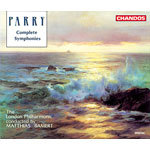
Parry: Complete Symphonies (Nos 1- 5)
 $72.00
Out of Stock
$72.00
Out of Stock6+ weeks add to cart
HUBERT PARRY
Parry: Complete Symphonies (Nos 1- 5)
London Philharmonic Orchestra, Matthias Bamert
[ Chandos Classics / 3 CD Box Set ]
Release Date: Friday 28 November 2003
This item is currently out of stock. It may take 6 or more weeks to obtain from when you place your order as this is a specialist product.
"Bamert proves a masterly interpreter and takes us convincingly through the symphonic terrain of a highly influential composer....The sound is rich and full to match the outstanding playing" Penguin Guide
""The Parry revival gathers pace. This is the first disc in a Chandos series which is to embrace the five symphonies and some of the choral works, including the rare and lovely The Lotus Eaters. A special significance attaches to it because the conductor is not British. Who would have expected a Swiss conductor, Matthias Bamert, to explore such a rare English preserve as the Parry symphonies? It is an encouraging act of faith, and the quality of the performances and interpretations is such as springs not from duty but from conviction and enthusiasm. Chandos give the music one of their clear and faithful recordings, with admirable balance and slight resonance.
As for the music, I find it difficult to understand how these works have remained virtually unplayed for so long. The Third (English) was composed in 1888-9 and, as Bernard Benoliel points out in his informative notes, is our equivalent of Mendelssohn's Italian and Schumann's Rhenish Symphonies, with a similar sunny exuberance. The orchestration has a light touch in the Scherzo and is richly Brahmsian in the Adagio. I find the finale (a set of variations) the weakest movement, rather four-square in its melodic cut and without the sweep of the opening Allegro.
But it is the Fourth Symphony in E minor that is the discovery. This was written concurrently with the Third and was first performed under Richter in July 1889. It did not please Parry, who re-wrote it in 1910 (and substituted the present Scherzo) for a Philharmonic Society concert. This recording is the first performance since that occasion 80 years ago. It strikes me as a more personal and confessional work than the Third, its 16-minute first movement full of repressed passion and romance, with a coda of radiant beauty leading into an Adagio of which Elgar would have been proud, as he would of the great tune in the finale (he would have marked it nobilmente!). That such music should have been collecting dust for nearly a century beggars belief."
(Original Gramophone Review on 3 & 4)
Recorded in:
St Jude on the Hill, Hampstead, London
20-22 May 1990, 5-6 January 1991, 9-10 January 1991 abd 6 January 1992
Tracks:
Symphony No. 1 in G major
Symphonic Variations (1897)
Symphony No. 2 in F major `The Cambridge`
Symphony No.3 in C major `The English`
Symphony No. 4 in E minor
Symphony No. 5 in B minor `Symphonic Fantasia`